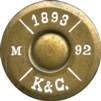This was one of the Austrian caliber reduction experiments during the early 1890’s.
The Austro-Hungarians, in line with other European powers began their research and development of a military 6.5mm cartridge during 1891. It was based on developments by Italy with their Mannlicher Carcano system and this resulted in the precursors for the M.93 Romanian Mannlicher. Cartridge development and research was done by Mannlicher in collaboration with Keller & Co. as competitors to Karl Krnka and the firm of Georg Roth, with Krnka serving as chief director from 1898 onward. The requirements were:
– Reducing the bullet diameter to create a cartridge with a danger space up to 1,200m;
– Reducing the weight of the ammunition a soldier has to carry;
– Improving the propellant. The Italians with their Carcano system experienced severe throat erosion in their rifles because of Ballistite as propellant, which lead them to change to Solenite;
– Improved bullet construction with steel coated lead core bullets. Initially the idea was to experiment with tungsten cored bullets, but no one had sufficient experience at that time in history to successfully work with tungsten.
Tests were done with three different diameter bullets, namely 5mm, 5.5mm and 6mm. Tests were conducted over a five year period between February 1892 to February 1897. Various problems were encountered namely failures to stabilise bullets in flight, jacket/core separations, bullets deflecting too easily, throat erosion, case ruptures and excessive pressures. Tests shown the 5mm diameter showed some promise and all further tests were done with these 5mm bullets in two different case lengths, namely 52mm and 55mm. It is interesting to note that wounding tests were conducted on live animals up to a distance of 1,500m. In the end the results were not as expected and this was attributed to the propellant technology not being able to achieve what they set as goals in the beginning.


